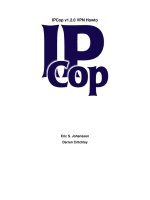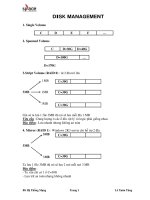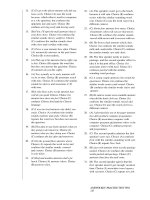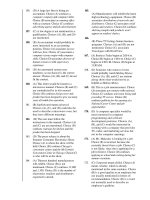Tài liệu Project Management 2.0 – The Ultimate Benefits of the New Approach to Project Management docx
Bạn đang xem bản rút gọn của tài liệu. Xem và tải ngay bản đầy đủ của tài liệu tại đây (171.3 KB, 10 trang )
Project Management 2.0 –
The Ultimate Benets of the New
Approach to Project Management
The most practical project management software
Project Management 2.0 –
The Ultimate Benets of the New Approach to Project Management
Introduction
The old models of how people interact and collaborate have been radically transformed in recent
times. People are using blogs, wikis and collaborative planning tools to work together. All these ap-
plications represent a signicant opportunity for organizations to create new social and Web-based
collaboration and increase productivity. Project management is undergoing signicant changes
due to the introduction of the new technologies for managing project teams.
Traditional project management implies a project manager acting as a proxy in all project-related
communications, thus reducing his productivity and therefore curtailing the eciency of the rest
of the project team. The new wave of project management tools puts an emphasis on collabora-
tion and makes teams much more productive. These applications go hand-in-hand with modern
practices like collective intelligence and emerging structures that empower agile project manage-
ment. These practices and tools are now used by successful teams ranging from two individuals to
thousands of people. They are not only incredibly helpful in managing distributed teams in today’s
global environment, but also able to take care of a lot of routine operations for you.
Wikis, blogs, collaboration tools, Web 2.0 technologies… How do these tools inuence contempo-
rary project management? How do they help you manage your projects? What makes them so eec-
tive? How can you get the most out of them? This article will help you to learn how companies and
teams can benet from the new technologies and practices, and how these technologies can make
your job easier and more pleasant.
New Opportunities for Businesses Brought by Enterprise 2.0
The social network phenomenon has already transformed the consumer Web into so-called “Web 2.0.”
Now Web 2.0 is aecting business processes in thousands of organizations by oering incredible com-
munication and collaboration opportunities known as “Enterprise 2.0.” “All these things that are thought
to be consumer services are coming into the enterprise,” says former Oracle Corp. President Ray Lane, now
a general partner at the venture capital rm Kleiner Perkins Caueld & Byers. Major corporations all over
the world, such as IBM, Procter & Gamble and Walt Disney, embrace Enterprise 2.0 technologies. We are
witnessing the transformation of traditional ways of doing business, and this transformation is caused by
the new-generation applications.
- 2 -
Copyright© Wrike, Inc. www.wrike.com
Project Management 2.0 –
The Ultimate Benets of the New Approach to Project Management
The term Enterprise 2.0 was coined by Andrew McAee, an associate professor at Harvard Business School,
in spring 2006. Professor McAee introduced this term to describe the use of emergent social software
platforms within companies, or between companies and their peers (partners or customers).
Through the adoption of wikis, blogs, collaboration planning tools, social networks and other “weapons of mass
collaboration,” as Don Trapscott calls them in his book “Wikinomics,” collaboration patterns are changed in
today’s organizations. Enterprise 2.0 software and business practices provide managers with access to the
right information at the right time through a system of interconnected applications and services. Examples
of thousands of small companies and giants like Microsoft, Toyota and many others show that Web-based
Enterprise 2.0 applications let businesses obtain a huge competitive advantage in the form of enforced
innovation, productivity and agility through access to the collective intelligence of many professionals.
Ecient gathering and sharing of information, facilitated social connections within enterprises and im-
proved customer interactions are not the only results that Enterprise 2.0 software delivers to small compa-
nies and huge corporations. Let’s see how these tools can help to manage projects.
The New Approach to Managing Projects
The Enterprise 2.0 movement naturally aected and later captivated project management in organiza-
tions. Blogs, wikis and other second-generation tools oer better opportunities for communication and
collaboration. Thus they provide a great potential for improving existing project management practices.
Traditionally, a project manager is the major link in all project-related communications. This directly inu-
ences the eciency of the team, as well as the manager’s own productivity. Nowadays, many companies
still utilize Microsoft Excel spreadsheets or traditional project management applications, like Microsoft
Project, for tracking their projects. E-mailing text documents and spreadsheets is still very popular, despite
its many shortcomings.
E-mail is a closed communication medium, and many companies conrm that it does a poor job of captur-
ing and sharing knowledge. For example, if you e-mail a document to two people, you then have three
copies of this document to manage, merge and dierentiate. It is hard to work on this document simulta-
neously. This is not the only problem. Knowledge is buried in e-mails, as it is available only to the sender
and the recipients, so all the other team members cannot benet from it. For example, if an employee
e-mails a status update to his manager, the change will only be visible to other people after the manager
manually updates the schedule. This produces unnecessary work and delays the exchange of information.
- 3 -
Copyright© Wrike, Inc. www.wrike.com
There is little visibility and control over the project if all information is buried in thousands of e-mails resid-
ing in employees’ mailboxes. The list of disadvantages could go on.
Traditional project management tools are not focused on collaboration, either. They were mostly designed
with the top-down approach in mind and are not meant for open collaboration. These tools are focused on
a project manager and make him the core element of the project communications. He rst has to pull facts
out of employees through meetings and e-mails, then put them into a le and communicate the project plan
to upper management and clients. The process is then repeated every time something changes. The project
manager also needs to play the role of an alarm clock, reminding employees of their deadlines and overdue
tasks. The whole process turns out to be time-consuming and eortful, and it results in a heavy burden for a
project manager. The amount of routine work sometimes does not leave the manager time for leadership.
Enterprise 2.0 technologies catalyze innovations in project management. These innovations can be called
Project Management 2.0. The term highlights a new approach to project management, characterized by a
dramatic shift toward having collaboration as the heart of managing projects. The new-generation tools
take care of the routine part of a project manager’s work: reminding team members about deadlines,
merging status updates into a single plan and communicating changes. New tools also let people collabo-
rate and share information easily. The role of the project manager is changing; he’s becoming a project
visionary, instead of a taskmaster. New-generation tools give him more space for being a project leader.
What makes the new technologies so eective? I will list the ve key benets below.
Making it simple to collaborate
One of the major constraints associated with traditional project management software was its complexity.
Traditional tools have hundreds of features, which take months to master. Adoption of traditional project
management software is often connected with spending a lot of the employees’ time and the company’s
money on training. On the contrary, the second-generation project management tools are lightweight
and easy to use. They provide an opportunity to start collaborating immediately, without any delays for
extensive learning and initial set-up.
New project management tools can be easily utilized even by unskilled computer users, making it pos-
sible to involve more people in project collaboration. A well-known example is blogging. It is very simple
to share ideas in a blog and get feedback in comments. Simplicity drives adoption. When people like the
software, they use it more often.
- 4 -
Copyright© Wrike, Inc. www.wrike.com
Project Management 2.0 –
The Ultimate Benets of the New Approach to Project Management
- 5 -
Copyright© Wrike, Inc. www.wrike.com
New software tools provide a much better user experience, which helps to solve one of the biggest chal-
lenges of traditional software packages. One of the major problems with traditional tools was the users’
unwillingness to update data regularly. Plans often got outdated and became useless because of that.
New tools are much more convenient to use. For example, users of Wrike’s project management software
can create tasks in the system by sending e-mails from their Blackberry devices. This level of simplicity and
convenience engages users and thus helps to keep information up-to-date. This is a critical component for
successful project management software implementation. The power of new tools comes to the surface
when they turn simple actions of individual users into a great product of collective work. In Enterprise 2.0
terms, it is called collective intelligence and emergent structures.
Taking advantage of the wisdom of the whole team
The new-generation, Web-based tools give team members an easy way to contribute to the common
repository of tasks and plans. These tools unleash the power of collective intelligence and change the pat-
tern of project management.
In his book “The Wisdom of Crowds,” James Surowiecki states that “groups are remarkably intelligent and
are often smarter than the smartest people in them. Groups do not need to be dominated by exceptional-
ly intelligent people in order to be smart.” He also stresses that “decentralization’s greatest strength is that
it encourages independence and specialization on the one hand while still allowing people to coordinate
their activities and solve dicult problems.”
With the new technologies, people get a more ecient working environment where they can gather and
share knowledge from dierent elds that each project team member is an expert in. The project manager
guides the team work and chooses the right direction, based on the information received from the indi-
vidual employees. The tools even help the manager to merge this information, turning an e-mail mess into
well-organized timelines. Now project managers can easily control changes and the progress of the proj-
ect work. Reporting is highly automated on all levels, including corporate executives, who get their view of
the project automatically. The reports are pulled on the y from real data, so they are up-to-date. All these
factors boost the team’s productivity and help the company make the right decisions at the right time.
Collective intelligence goes hand-in-hand with emergent structures, another practice that has a great im-
pact on contemporary project management.
Project Management 2.0 –
The Ultimate Benets of the New Approach to Project Management
Many-to-many structure benets
Microsoft Project and many other traditional management tools allow you to have only a strict, one-to-
many work breakdown structure of tasks (and other similar items). This creates several negative conse-
quences. First, there can be only one view on the project, while in real life there might be a need to have
many dierent views of the same project. Project marketers, business analyst, engineers and QA people
might want to slice the project in dierent ways. Often, the same person needs dierent slices— for exam-
ple, by release and by feature. This inconvenience makes the software less usable and thus people become
hesitant to check plans and update them regularly. The more important issue is that a schedule, which has
only one strict hierarchical organization, is really hard to change when you need to reorganize things. On
one hand, these factors lead to obsolete and useless project plans. On the other hand, they increase the
cost of errors in the initial design of the information hierarchy. The whole process becomes very tricky and
requires a lot of up-front thinking, predictions and responsibility for a project manager.
In collaborative planning tools, like Wrike, hierarchies are many-to-many, in contrast to the one-to-many
hierarchy in Microsoft Project. That makes it really easy to reorganize tasks and evolve the schedule. Proj-
ect plans become more exible, which means that a project manager and his team can react to changes
going on inside and outside the organization much faster. This agility helps to bring iterative and incre-
mental practices into project management without giving away the control.
Project management 2.0 tools allow you to start from a structure with one item and evolve it into a model
that perfectly suits the project. This helps to make bottom-up planning possible, and that is crucial for
unleashing the power of collective intelligence in project management.
Empowered by emergent structures and collective intelligence, project managers can combine eld
knowledge coming bottom-up with the guidance coming top-down. There is also a signicant benet
for top managers: emerging structures allow you to get complete visibility that bridges the gap between
strategic corporate plans and daily to-do lists of employees.
- 6 -
Copyright© Wrike, Inc. www.wrike.com
Project Management 2.0 –
The Ultimate Benets of the New Approach to Project Management
- 7 -
Copyright© Wrike, Inc. www.wrike.com
Getting the bigger picture
Full insight into what is going on in the organization is vital for aligning internal business resources with
the requirements of the changing environment. For example, if we speak of software development, the
bug xing schedule may aect the next release schedule. The next release schedule in its turn may aect
the marketing campaign, which may aect sales plans. Sales plans will naturally have an impact on nan-
cial plans. Having the whole picture helps to make a better choice for allocating internal resources when
there is a need to react properly to the changes in the business environment. Emergent structures and
many-to-many hierarchies are the best way to compose this picture, so project management 2.0 tools are
naturally able to provide this “big picture” view.
When project managers can easily view every detail of their project development, and corporate execu-
tives are able to use their business resources most rationally, projects bring value faster.
Productivity boost
With new tools, project managers save hours on routine operations related to aggregating the informa-
tion from e-mails and meetings and keeping it up-to-date. Reporting is simplied on all levels, as part of
it can be easily achieved by sharing the related part of the collaborative workspace. Second-generation
project management software gives every team member an opportunity to be aware of the changes in
the project without unnecessary meetings, e-mails and phone calls. The collaboration becomes much
faster and much more productive. It results in faster project delivery and faster return on investment.
To start innovation and improvements in your organization is easy. As we have already mentioned, new
tools are very user-friendly and easy to adopt. You just have to pick the right ones.
Project Management 2.0 –
The Ultimate Benets of the New Approach to Project Management
Project Management 2.0 tools – a new collaborative space
Perhaps the most popular of the new-generation applications that companies can benet from are blogs,
wikis and collaboration planning tools.
Blogs
Both internal and external use of blogs can be advantageous for a project. The major benet of internal
blogging is that it gives the opportunity to facilitate direct communication between various layers of an
organization. Blogs allow team members who otherwise would not have been aware of or invited to par-
ticipate in a discussion to contribute their expertise. Thousands of companies now use blogging tools like
Blogger, LiveJournal, Typepad, Movable Type, WordPress or Radio UserLand. For example, British Library
and University College London collaborate on a project called the LIFE (Lifecycle Information for E-Liter-
ature) through a blog. A blog is a way for these two organizations to work together more eciently and
keep all the project information in one place.
External blogging helps to encourage the strongest community goodwill, and this goodwill, in turn, pro-
motes signicant marketing and sales gains. Thousands of companies are already reaping the rewards of
their investment in external project blogging. For, example, companies like Microsoft, IBM, Google, Sun
Microsystems and SAP write project blogs on a regular basis. The number of non-technology organiza-
tions that have their own project blogs is rapidly growing, too. One of the most prominent examples is the
From Edison’s Desk blog – a blog for the GE Global Research project. It oers an opportunity for technol-
ogy enthusiasts around the globe to discuss the future of technology with top researchers from one of the
world’s largest and most diverse industrial research labs.
Wikis
Wiki is another technology that can be successfully applied to managing projects. Its basic advantage is
that it lets users to create, edit and link Web pages easily. Wikis usually have very little restrictions, thus
they tend to accumulate a shared knowledge that was traditionally kept out of sti corporate enterprise
software and intranets— the knowledge that was usually buried in e-mails. A good example of wiki usage
would be Dresdner Kleinwort, the investment banking division of Dresdner Bank AG that gained an e-mail
- 8 -
Copyright© Wrike, Inc. www.wrike.com
Project Management 2.0 –
The Ultimate Benets of the New Approach to Project Management
- 9 -
Copyright© Wrike, Inc. www.wrike.com
trac volume reduction by 75%. They also slashed meeting time in half. Another example is a Linux-based
operating system called Fedora, which uses a project wiki to bring the end user’s point of view into the
product development. There are a lot of wiki solutions that are be successfully used by many companies.
The most well-known is an open source wiki called MediaWiki, the one that is used by Wikipedia.
Wikis and blogs are good generic tools that can help to share knowledge much eectively than e-mails. To
get a visibility and control over operations, companies also need to empower their managers and employ-
ees with a collaborative planning solution.
Collaboration planning tools
New collaboration applications and platforms combine the level of control associated with traditional
project management software with the benets of web 2.0 applications to give a productivity boost to
companies and bring a better visibility. The best tools in this eld are integrated with e-mail, easy to adopt
and inexpensive to adopt. They democratize project management software.
Collaboration planning tools bridge the gap between employees’ to-do lists, project plans and strategic
goals. With the help of these tools, a project manager gains complete visibility of all the projects he is re-
sponsible for. The upper management knows what is going on inside of every project and has the whole
picture. The software takes a lot of routine operations on its shoulders – turning e-mail mess into a nice-
looking timeline, reminding people about overdue tasks and building reports. These tools help to collect
information and make it accessible to any team member anywhere. This expedites information sharing
and accelerates decision making.
Governmental, educational, commercial and non-prot organizations all over the world embrace project
management 2.0 tools to improve their project management. Corporations like McDonalds, Walt Disney,
Apple, Toyota and Capgemini utilize second-generation project management applications within their
departments. I work for one of the companies that leads the collaborative planning space, Wrike.
Project Management 2.0 –
The Ultimate Benets of the New Approach to Project Management
- 10 -
Copyright© Wrike, Inc. www.wrike.com
Conclusion
The use of innovative project management technologies promises to have a profound and far-reaching
eect on how projects are managed today. These technologies let companies acquire the key ingredient
to success in any business – they help companies make better decisions faster. Project management 2.0
gives a great productivity boost to project managers and their teams.
Today, the project management landscape is changing, opening new competitive advantages for com-
panies. While some companies are struggling with the pains of traditional project management tools and
e-mail, others are becoming more ecient and innovative by leveraging the benets of the new technolo-
gies. I hope this article will help you adopt some of the Project Management 2.0 tools and practices.
Author: Andrew Filev
Since 2001, Andrew Filev has been managing software teams in a global environment. His technical
expertise and his management vision are reected in online and oine articles that have had hun-
dreds of thousands of readers. His ideas on new trends in project management are published in the
Project Management 2.0 blog. Andrew has given speeches on new trends in project management and
deployment of the next-generation, Web-based applications on deferent events, including the PMI Sil-
icon Valley Tools and Techniques Forum and the Oce 2.0 Conference (Project Management panel).
Andrew’s innovative ideas and passion to improve project management tools are applied in Wrike,
a leading online project management solution. Andrew now leads the company as a founder and CEO.
About Wrike
Wrike, Inc. is a provider of an award-winning, on-demand, online project management solution. It
provides executives with a unique platform for gaining productivity for the whole team and get-
ting things done throughout the company. Wrike helps companies from SMBs to global corpora-
tions to stay in control of their business ( Its e-mail integration
is the most advanced in the project management space. Wrike, Inc. has patents pending. Wrike was
named a winner of RedHerring’s Top 100 Global Company Award and a winner of eWeek’s Excel-
lence Award. Founded in 2003, Wrike Inc. is a privately held corporation located in California.
Project Management 2.0 –
The Ultimate Benets of the New Approach to Project Management









